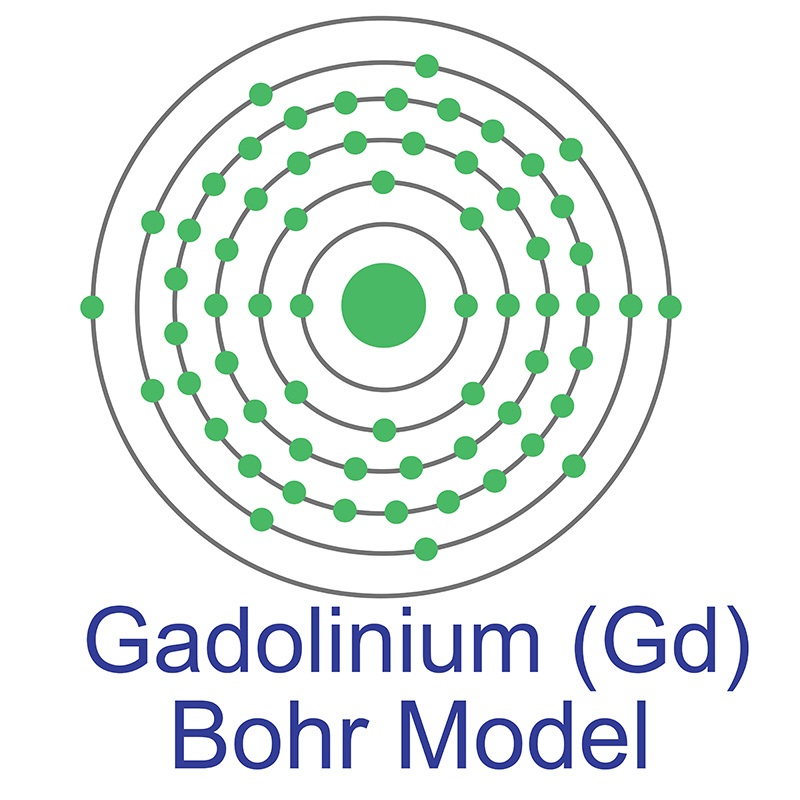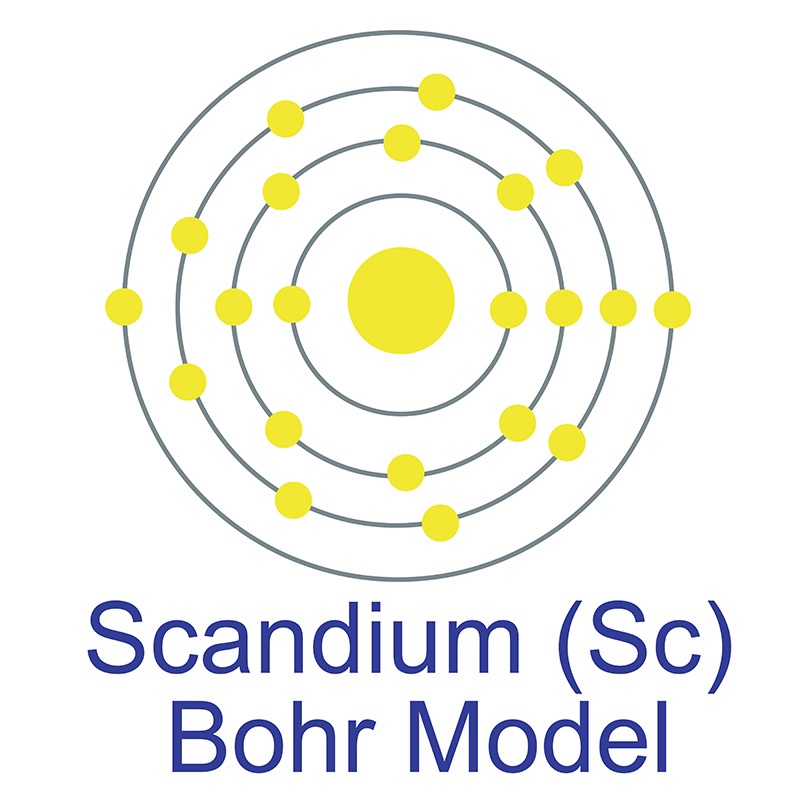See more Gadolinium products. Gadolinium (atomic symbol: Gd, atomic number: 64) is a Block F, Group 3, Period 6 element with an atomic radius of 157.25.  The number of electrons in each of Gadolinium's shells is [2, 8, 18, 25, 9, 2] and its electron configuration is [Xe] 4f7 5d1 6s2. The gadolinium atom has a radius of 180 pm and a Van der Waals radius of 237 pm. Gadolinium was discovered by Jean Charles Galissard de Marignac in 1880 and first isolated by Lecoq de Boisbaudran in 1886. In its elemental form, gadolinium has a silvery-white appearance. Gadolinium is a rare earth or lanthanide element that possesses unique properties advantageous to specialized applications such as semiconductor fabrication and nuclear reactor shielding.
The number of electrons in each of Gadolinium's shells is [2, 8, 18, 25, 9, 2] and its electron configuration is [Xe] 4f7 5d1 6s2. The gadolinium atom has a radius of 180 pm and a Van der Waals radius of 237 pm. Gadolinium was discovered by Jean Charles Galissard de Marignac in 1880 and first isolated by Lecoq de Boisbaudran in 1886. In its elemental form, gadolinium has a silvery-white appearance. Gadolinium is a rare earth or lanthanide element that possesses unique properties advantageous to specialized applications such as semiconductor fabrication and nuclear reactor shielding.  It is utilized for both its high magnetic moment (7.94μ B) and in phosphors and scintillator crystals. When complexed with EDTA ligands, it is used as an injectable contrast agent for MRIs. The element is named after the Finnish chemist and geologist Johan Gadolin.
It is utilized for both its high magnetic moment (7.94μ B) and in phosphors and scintillator crystals. When complexed with EDTA ligands, it is used as an injectable contrast agent for MRIs. The element is named after the Finnish chemist and geologist Johan Gadolin.
Materials
Materials by Form
2D Materials Alloy & Alloy Forms Pure Metals & Metal FormsCeramic FibersFoams: Metallic & Ceramic High Purity Materials Isotopes MXenesOxides Rare Earths Semiconductors Solutions
Chemicals & Salts
All Chemicals & Salts Acetates Aluminides Ammonium Sulfates Antimonides Arsenates Benzoate Bromates Bromides Carbonates Chlorides Chromates Fluorides Hydrides Hydroxides Iodates Iodides Lactates Molybdates Nitrates Oxalates Oxides Perchlorates Phosphates Selenates Selenides Selenites Silicates Stearates Sulfates Sulfides Sulfites Tantalates Tellurates Tellurides Tellurites ThiocyanatesVanadates
Ceramics
Nanomaterials
Organometallics
Materials by Application
Additive Manufacturing & 3D Printing Battery & Supercapacitor Materials Catalysts Dental Materials Electronics Materials Fuel Cell Materials Fusion EnergyGlass Manufacturing Green Technology & Alternative Energy Hydrogen Storage Laser Crystals Life Sciences & Biomaterials Metallurgy Nanotechnology & Nanomaterials Optical Materials Photovoltaic & Solar Energy Plating Pigments & Coatings Research & Development Space Technology Sputtering Targets Thin Film Deposition Water Treatment Weather Modification
Life Science Chemicals
Life Science Products AlcoholsAldehydesAmidesAminesAmino Acids & DerivativesAromaticsArylsAzetidinesBenzimidazolesBenzisoxazolesBenzodioxansBenzofuransBenzothiazolesBenzothiophenesBenzoxazolesCarboxylic AcidsEnzymes & InhibitorsEstersEthersFluorinated Building BlocksFuransHalidesImidazolesImidazolidinesIndazolesIndolesIndolinesIsoquinolinesIsoxazolesKetonesMorpholinesNaphthyridinesNitrilesOrganoboronOrganosiliconOxadiazolesOxazolesPharmaceuticals & IntermediatesPhenolsPhytochemicalsPiperazinesPiperidinesPyrazinesPyrazolesPyridazinesPyridinesPyrimidinesPyrrolesPyrrolidinesPyrrolinesQuinazolinesQuinolinesQuinoxalinesSpiroesSulfonyl ChloridesTetrahydroisoquinolinesTetrahydropyransTetrahydroquinolinesTetrazolesThiadiazolesThiazolesThiazolidinesThiolsThiophenesTriazinesTriazoles
About Us
Locations
Austria Belgium Brazil Canada China & Hong Kong Czech Republic Denmark Finland France Germany Greece Hungary India Indonesia Israel Italy Japan Malaysia Mexico Netherlands Norway Philippines Poland Portugal Russia Singapore South Korea Spain Sweden Switzerland Taiwan Thailand Turkey United Kingdom United States
Industries
Aerospace Agriculture Automotive Chemical Manufacturing Defense Dentistry Electronics Energy Storage & Batteries Fine Art Materials Fuel CellsFusion Energy Glass Investment Grade Metals Jewelry & Fashion Lasers Lighting Medical Devices Museums & Galleries Nuclear Energy Oil & Gas Optics Paper & Pulp Pharmaceuticals & Cosmetics Research & Laboratory Robotics Solar Energy Space Sports Equipment Steel & Alloy Producers Textiles & Fabrics Water Treatment Municipalities
Follow Us

 The scandium atom has a radius of 162 pm and a Van der Waals radius of 216 pm.Scandium was predicted by Dmitri Mendeleev in 1871 and actually discovered and isolated by Lars Nilson in 1879. One of the
The scandium atom has a radius of 162 pm and a Van der Waals radius of 216 pm.Scandium was predicted by Dmitri Mendeleev in 1871 and actually discovered and isolated by Lars Nilson in 1879. One of the  It is occasionally included in the classification of the
It is occasionally included in the classification of the 